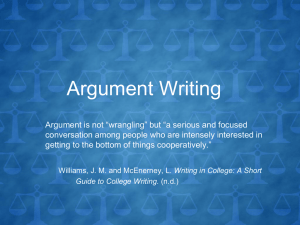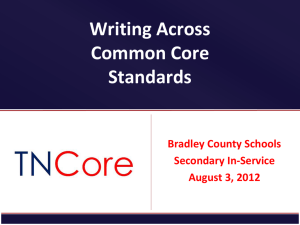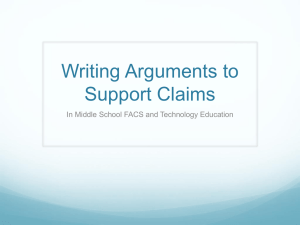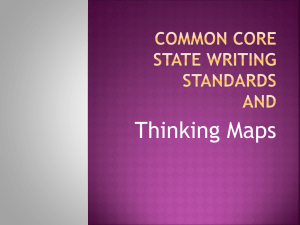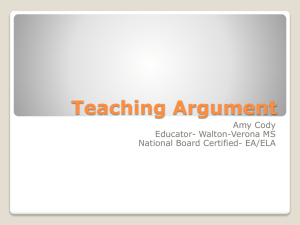MS Argument Writing2 - Transition to Common Core
advertisement
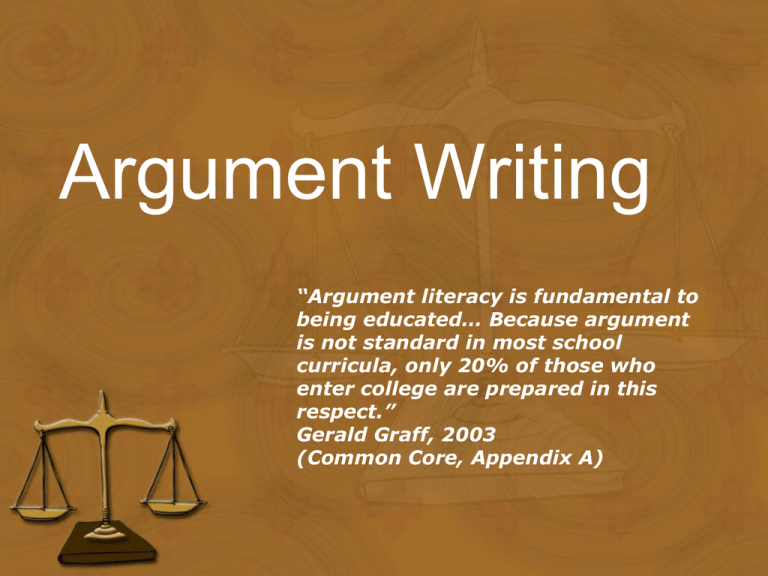
Argument Writing “Argument literacy is fundamental to being educated… Because argument is not standard in most school curricula, only 20% of those who enter college are prepared in this respect.” Gerald Graff, 2003 (Common Core, Appendix A) What is an argument? An argument is a “claim” that must be supported by evidence. Differences Persuasion Argument Attempts to convince the reader to accept a thesis as truth. Attempts to convince the reader to accept a claim as truth. Appeals to the credibility, character, or authority of the writer (ethos). Focuses on evidence (logos). Is often grounded more in feelings (pathos) than in facts. Is grounded more in facts, data, and logic. Is often associated with speeches and frequently requires listeners/ readers to take some sort of action to remediate an issue. Requires critical reading of the text(s); may include evidence from other sources. Addresses counterclaims fairly in order to present a complete argument An Effective Claim • Takes a clear position • Is debatable – people could reasonably have different opinions on the issue • Is narrow enough to be supported effectively within the scope of the assignment Teaching How to Focus a Claim • A claim is a statement with which others may agree or disagree. It is not an opinion. • Non-claim Margot is the sympathetic figure in the story “All Summer in a Day.” • Claim Revision Margot misses the anticipated hour of sun because of her classmates’ actions, but she has really brought this punishment on herself. Types of Claims • Claims of cause and effect • Argues that one person, thing, or event caused something else to occur • Claims of definition or fact • Argues what a definition is or if something accepted as a “fact” is really so • Claims about values • Argues the worth of something and whether we value it or not. • Claims about solutions or policies • Argues for or against specific approaches to problems. Why Address Counterclaims? Acknowledging counterclaims — • Enhances the writer’s credibility and thoroughness • Recognizes that the reader may have a different point of view. “Conceding that the opposing point is valid and then building upon it to further one’s own claim allows a writer to make the audience feel appreciated without giving up her or his own position.” http://www.winthrop.edu/wcenter/wcenter/toulmin.htm Organizational Structure Introduction • Present the claim – a debatable statement Body • Present evidence to support the claim o Cite credible sources o Make a connection between the evidence and the claim • Present counterclaim(s) o Cite credible sources o Make a connection between the evidence and the claim Conclusion • Concluding statement or section that follows from and supports the argument presented Links to Support Argument Writing • Common Core English Language Arts Standards http://www.corestandards.org/the-standards/english-language-arts-standards • Appendix A: Research supporting key elements of the standards http://www.corestandards.org/assets/Appendix_A.pdf • Appendix B: Text exemplars and sample performance tasks http://www.corestandards.org/assets/Appendix_B.pdf • Appendix C: Samples of student writing http://www.corestandards.org/assets/Appendix_B.pdf • Application to ELL and students with disabilities http://www.corestandards.org/assets/application-for-englishlearners.pdf http://www.corestandards.org/assets/application-to-studentswith-disabilities.pdf
